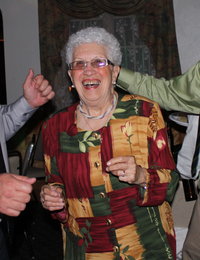 Carver – Margaret Wilson, 89, has always enjoyed dancing. She has fond memories of couple dancing with her husband over many years. Following his death in 2002, Wilson wanted to stay active, and after moving into a mobile home park in Carver, she started line dancing with a group in the clubhouse.
Carver – Margaret Wilson, 89, has always enjoyed dancing. She has fond memories of couple dancing with her husband over many years. Following his death in 2002, Wilson wanted to stay active, and after moving into a mobile home park in Carver, she started line dancing with a group in the clubhouse.
As Wilson grew older, she weathered “typical” challenges for a woman of her
age, including knee and hip placements and macular degeneration. Then, early in 2015, she developed an irregular heartbeat, had less energy, and started to experience shortness of breath. Thinking of her husband and fearing that her own health was failing, she hoped there would be a solution for her.
There was.
In July 2015, her cardiologist referred her to the CardioVascular Institute (CVI) at Beth Israel Deaconess Medical Center (BIDMC) in Boston, for treatment of aortic stenosis. This narrowing of the aortic valve leads to weakened heart function and reduced blood flow from the heart to the body. The CVI is a center of clinical research in aortic valve therapies and offers a range of treatments.
Meeting With The Team
At the CVI, Wilson met with her team, interventional cardiologist Jeffrey Popma, MD, director of interventional cardiology clinical services, and Kamal R. Khabbaz, MD, chief of cardiac surgery. They admitted her to the hospital immediately.
Unfortunately, Wilson was not a candidate for surgical aortic valve replacement (AVR), the traditional open heart surgery for patients with severe aortic stenosis. Her new doctors told her about an alternative therapy: a minimally invasive procedure called transcatheter aortic valve repair (TAVR). Popma and Khabbaz are recognized experts in this therapeutic approach, having both been active as
principal investigators in TAVR clinical trials. The procedure involves implantation of a bioprosthesis—a synthetic valve– to take over for her diseased valve. This is done nonsurgically, through a catheter, or tube, that is inserted through an artery and into the heart.
“It was just fine with me that I’d avoid open heart surgery,” says Wilson.
Prior to the procedure, she had a CT scan to help her doctors determine where to insert the catheter, as well the proper sizing for the valve and catheter. Fortunately, with the wide range of bioprosthesis options available at the CVI, there was one that would fit through her narrow blood vessels. During the procedure, which typically lasts two hours, doctors inserted the catheter through Wilson’s groin and guided the new valve into position. It immediately began functioning as a replacement for her native valve.
Back to the Dance
Wilson took her first steps the day after the procedure. Four days later, she was discharged with
no complications. Within a week, she started to resume normal activities. And a month later, at her BIDMC check-up, she saw Popma and Kim Guibone, the lead nurse practitioner, who said she was doing “amazingly well.”
“I’m very grateful that I had this option available to me,” says Wilson, who learned that without the TAVR procedure, there had been a 50 percent chance that she wouldn’t survive more than a year. She
adds, “I actually feel 10 years younger! I’m back on the dance floor, I go bowling, I take fitness classes, and most of all, I’m here to enjoy my kids, my grandkids, and my great-grandkids…all 12 of them!
This story was contributed by Gary Woonteiler, President of Woonteiler Ink. For more information you
may visit the BIDMC web site at www.bidmc.org.

